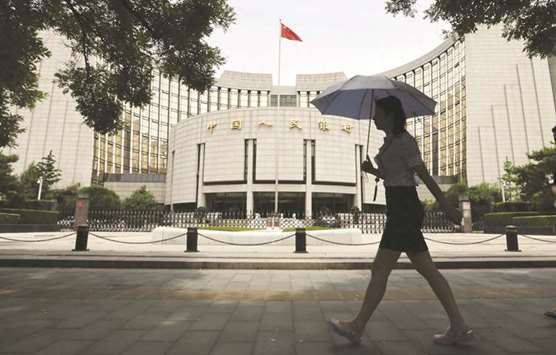China’s central bank said yesterday that it will not resort to strong stimulus to support the slowing economy but will keep liquidity reasonably ample and offer more help to companies which are having trouble obtaining financing.
Officials also reiterated that China will not use the yuan as a weapon to deal with trade frictions, a day after US President Donald Trump told Reuters Beijing was manipulating its currency in response to US tariffs on imported Chinese goods.
Policies will be made more forward looking, flexible and effective, the People’s Bank of China (PBoC) said in a statement issued at a briefing in Beijing.
The rare central bank news conference follows a spate of weaker readings from the world’s second-largest economy in recent months, a sharp drop in the yuan against the dollar and a plunge in Chinese stock markets.
With China’s economy cooling and the impact of US trade tariffs still to be felt, its policymakers are shifting their priorities to reducing risks to growth.
Smaller companies, in particular, are having a tough time securing loans and are grappling with rising borrowing and operating costs, fuelled in part by a lengthy official clampdown on riskier lending like shadow banking.
“For companies facing temporary difficulties, we encourage financial institutions not to cut off loans, said Ji Zhihong, the head of the PBoC’s financial markets department, when asked about support measures for exporters impacted by rising trade protectionism.
“If the product has a market or future, we support banks to provide reasonable support,” said Ji.
The PBoC said it will “effectively ease” companies’ financing problems and improve co-ordination with other agencies to ensure monetary policy measures are being transmitted into the broader economy.
Though it did not give details, analysts expect further cuts in corporate taxes and fees.
The central bank also has specified that some funds freed up from reductions in banks’ reserve requirements should be earmarked for loans to smaller businesses. Beijing is accelerating infrastructure spending to cushion the economy as it braces for the blow from escalating US tariffs.
The growing stream of new stimulus measures and easing credit policies has raised fears that Beijing is putting debt reduction efforts on the back burner again. However, PBoC vice governor Zhu Hexin told the briefing that authorities will stay the course in their multi-year campaign to reduce risks in the financial system.
“The direction of structural deleveraging won’t change,” said Zhu.
The campaign is already paying dividends, with the macro economic leverage ratio stabilising and growth in the household debt ratio slowing, he added.
“The effectiveness of deleveraging needs to be improved.
It’s the bad, inefficient leverage that needs to be gotten rid of.
Some departments with high efficient leveraging can still add more debt.”
Analysts at Julius Baer agree Beijing is unlikely to repeat its large-scale stimulus of the past, predicting it will opt for a more measured response.
“We doubt that this (heavy spending) is in the government’s interest, as it is aware of the risk that its massive mountain of debt presents and will likely not want to jeopardise deleveraging and reform efforts made over the past two years,” they said in a note on Tuesday.
Vice Premier Liu He said on Monday that China needs to beef up capital markets and broaden financing channels for small and medium enterprises.
But the effectiveness of such moves is far from clear.
Policymakers have tried for at least eight years to improve financing for smaller firms, but most analysts say the problem has only grown worse, with state-backed companies continuing to get the lion’s share of cheaper credit.
China’s economic growth rate slowed slightly to 6.7% in the second quarter year-on-year, still well above the government’s full-year target of around 6.5%. But some key activity indicators have weakened more sharply and policymakers are getting edgy.
Fixed-asset investment is growing at the slowest pace on record, while non-performing loans surged in the second quarter and defaults climbed.
The July nationwide jobless rate rose to 5.1%.
“So far, the monetary easing seen in June and July has not turned around overall credit conditions and a stabilisation of overall credit growth will likely take one or two quarters,” Julius Baer said.
“Thus, we see yearly Chinese growth slowing further towards 6.2% by the end of 2018 before stabilising in the middle of 2019.”

A pedestrian walks past the People’s Bank of China building in Beijing. The PBoC said it will u201ceffectively easeu201d companies’ financing problems and improve co-ordination with other agencies to ensure monetary policy measures are being transmitted into the broader economy.


